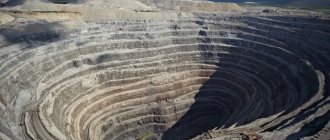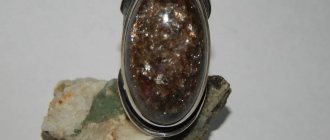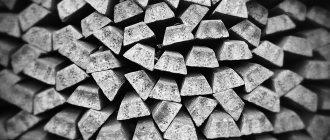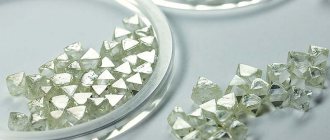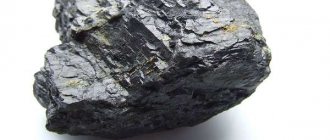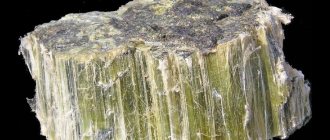Extraction methods
More than half of titanium is mined from placers. Mining in sand deposits is not difficult. The process is quite simple and does not require crushing and grinding; it is carried out by dredges, dredgers, excavators, scrapers and other hydraulic devices.
Career
It’s a different matter when the ores occur in veins at shallow depths. Depending on the hardness of the overburden, it is necessary to resort to their removal using earth-moving mechanisms or through preliminary drilling and blasting operations. After which, the removed ore is taken and subjected to crushing and grinding for further processing.
Shakhtny
The mining method is applicable in the development of primary deposits. This is the most expensive and time-consuming method, requiring the construction of a whole complex of complex underground structures, the costs of which are recouped by obtaining a whole set of minerals contained in titanium-containing ores.
Description of the stone and its healing properties
Due to the high iron content in ilmenite, lithotherapists recommend using it to treat blood diseases. With the help of the mineral you can cure anemia, increase hemoglobin and the content of microelements in the blood. Beads or bracelets made of titanium iron ore will help in the fight against iron deficiency. It is important to remember that even for medicinal purposes, the mineral should not be worn by representatives of such zodiac signs as Aries, Leo and Sagittarius. No other medicinal properties, except for the effect on the circulatory system, have been identified in iron ore.
As already noted, ilmenite has a variable composition. With a high iron content, the stone can serve as a magnet. Titanium is obtained from it - one of the strongest metals. With a low content of iron oxide, the mineral is non-magnetic, which has a positive effect on its use for industrial purposes.
It is very rare to find ilmenite in jewelry. This is due to the fact that it is an ore of heavy metals and is mainly used in industry. In rare cases, beads and bracelets are made from ilmenite, which are then used for medicinal and prophylactic purposes. Of particular interest to collectors are “iron roses” - black crystals that have a complex shape.
Lithotherapists advise wearing mineral bracelets for those who are exposed to heavy physical activity. The stone raises hemoglobin levels and saturates the blood with oxygen. At the same time, when wearing products with ilmenite for a long time, it is recommended to periodically take a general blood test. An elevated hemoglobin level is just as dangerous to health as a low one.
It cannot be said that the mineral is capable of subordinating the will of its owner. That is why products made from this stone are recommended to be purchased only by those men who are confident in their inner strength.
Enrichment methods
Since the percentage of titanium dioxide (the main mineral of titanium ores) varies depending on the deposit, the extracted rock is subjected to enrichment, divided into two stages: separation of the empty mass and separation of individual minerals.
Wet and dry separation by specific gravity
Due to the different densities of titanium-containing rocks and masses that do not possess this natural mineral, it becomes possible to separate them in an aqueous or air environment under the influence of physical forces created inside special technical units. These are the so-called gravitational methods of enrichment of the extracted material.
Flotation
The ability of various materials to be retained or not to be retained at the interface of media that are usually in liquid and gaseous states has found wide application in the enrichment of titanium ores.
Depending on the initial mineral, chemical substances that form the flotation medium use their specific properties. Thus, for ilmenite, collectors in the form of fatty acids act as such media. Rutile floats well with oleic acid or sulfonated hydrocarbon derivatives. Perovskite must be treated with sulfuric acid before flotation with fatty acids. There are many flotation methods and technologies, and they also vary depending on the deposit.
Recently, tall oil has become widespread as a flotation material. However, processors are guided by considerations of cost, availability, and minimum toxicity when choosing material for flotation.
Magnetic and electrical separation
The difference in the magnetic and electrical properties of titanium from other minerals forms the basis for the corresponding separations - technologies for separating the desired material from waste rock under the influence of electric and magnetic fields in special devices. Their list includes: separators, iron separators, magnetizers and demagnetizers. And the principle of operation of these devices is based on changing the trajectory of movement in a force magnetic or electric field.
Metallurgical method
The final stage of obtaining titanium slag is the melting of the concentrate in the form of pressed briquettes in electric arc furnaces at a temperature of 1500-17000 C. The castings formed as a result of the metallurgical method contain up to 80% titanium.
Mineral composition of titanium ores and deposits
Titanium is one of the most common elements in the earth's crust, its weight content is 0.62%.
It is found in all igneous and sedimentary rocks in the form of dioxide and salts of titanic acid - titanates. Titanium is prone to the formation of complex anions, including zirconium, niobium, and silicon. In this regard, in addition to minerals that are simple titanates, complex titanium-niobates, silicotitanes and other compounds are found. About 70 titanium minerals are known. Titanium is found in even more minerals as an impurity. Of the titanium minerals themselves, the most common are ilmenite, rutile, perovskite and sphene (Table 131).
Ilmenite (titanium iron ore) contains 36.8% Fe, 31.6% Ti and 31.6% O. It may contain Mg and Mn as isomorphic impurities. The color of ilmenite is iron-black or steel-gray. The line is mostly black, sometimes brown or brownish-red. The luster is semi-metallic, opaque. Ilmenite is weakly magnetic. Its hardness is 5-6, specific gravity 4.72.
Rutile contains 60% Ti. It contains impurities of Fe, sometimes Sn and occasionally Cr. The color of rutile is usually dark yellow, brown, red and black. The line is yellow, light brown. Diamond to metallic luster. Rutile has a hardness of 6 and is brittle. Specific gravity 4.2-4.3. Brookite and anatase are two modifications of rutile. The color of brookite is yellow or red-brown to black. The line is colorless to grayish or brownish yellow. Diamond shine. The hardness of brookite is 5-6, specific gravity 3.9-4.0.
Perovskite contains 58.9% TiO2 and 41.1% CaO. It contains impurities of Fe, sometimes Al and Cr in small quantities. The color of perovskite is grayish-black. reddish-brown, orange-yellow and light yellow. The streak is white or grayish-yellow. Diamond blade. Perovskite hardness is 5.5–6, specific gravity 3.97–4.04.
Sphene (titanite) contains 40.8% TiOj, 30.6% SiO2 and 28.6% CaO. It often contains Fe impurities. sometimes Mg, Mn and Al, occasionally Cr, Zr and Nb. The color of sphene is yellow, brown, green, gray. The line is white. The shine is close to diamond, or diamond, greasy. The hardness of sphene is 5-6. specific gravity 3.29-3.56.
Of the large number of titanium minerals, only ilmenite and rutile are widespread and have the greatest industrial importance. All other titanium minerals are of secondary importance in terms of quantity and distribution.
Of these two important titanium minerals, rutile was used almost exclusively until recently. The value of rutile is explained by its high titanium content and the comparative simplicity of methods for its extraction. Much more common is ilmenite, which in its pure form contains half as much titanium as rutile. Ilmenite contained in ilmenite ores is in most cases very closely associated with other minerals, mainly magnetite and hematite, and their separation is always associated with certain difficulties. Currently, the largest part of titanium is obtained from ilmenite ores.
Rutile is usually found together with alkaline rocks in granites. quartz veins and pegmatites; Ilmenite is found, as a rule, in connection with the main rocks. Both minerals - rutile and ilmenite - were not destroyed during the weathering of bedrock and were concentrated in marine and river alluvial sediments.
Just a few years ago, the bulk of titanium concentrates on the market were obtained from alluvial deposits. Currently, most titanium is obtained by processing bedrock ores of primary deposits.
In capitalist countries, primary and placer deposits of titanium are being developed. In terms of reserves, primary deposits occupy the first place; large reserves are also concentrated in marine coastal placers, which provide about half of all titanium production in capitalist countries.
Among the primary deposits, deposits of igneous origin associated with basic and ultrabasic rocks of gabbroic magma and alkaline rocks are of primary importance. Among placer deposits, modern marine placers are of greatest importance. The largest of them are located in India on the Travancore coast, in Australia, the USA, Brazil, and Senegal. In the deposits of India and Senegal, the main mineral is ilmenite, while the rutile content is insignificant; in other deposits (Queensland in Australia) rutile predominates.
Alluvial placers, developed in Brazil, Malaya, and Cameroon, play a significant role in titanium mining. In Malaya, ilmenite is extracted as a by-product from tin deposits. In Cameroon and Brazil, the main titanium mineral is rutile, accompanied by zircon and, in places, monazite. In Cameroon, placers of rutile are also being developed in the eluvium of Precambrian paragneisses and shales.
The content of titanium minerals in placers varies widely. In India and New Zealand, the ilmenite content is 50-65%; in Australia, the content of heavy minerals (rutile, zircon, ilmenite and monazite) in placers ranges from 10 to 22%.
In the USA, titanium is mined both from rutile-ilmenite deposits themselves (bedrock and placer deposits) and from complex ilmenite-magnetite deposits with a high content of titanium dioxide.
A significant amount of high-grade rutile concentrates are obtained from the Roseland rutile-ilmenite deposit (Virginia). The deposit is associated with an intrusion of feldspathic rock (aplite) cutting through granite gneisses. Rutile and ilmenite in the form of small grains are located along cracks in crushing zones. The ore contains a significant amount of apatite. The rutile content in feldspathic rock is about 4%. Based on the ores of this deposit, there is a processing plant with a capacity of about 2 thousand tons of rutile per year.
In the area between Charlotteville and Lynchburg, Virginia, feldspathic intrusions cutting through Precambrian biotite shales are associated with nelsonite dykes and veins, consisting primarily of ilmenite, rutile, and apatite. The ore contains phlogopite, quartz, pyrite, biotite, chlorite, and actinolite. Some dikes are dominated by ilmenite, others by rutile. The rutile content in ilmenite veins averages 5-6%; in rutile veins proper it reaches 55-60%. The ilmenite content reaches 9.7% in rutile and up to 80% in ilmenite veins.
The Yadkin field is being developed in North Carolina. The ore body is lens-shaped, approximately 800 m long, 13.5 m wide, and occurs in sericite shales. The ore contains ilmenite and rutile with chlorite, serpentine and talc. The average content of titanium dioxide in ore is 30-35%.
The Machet Cove deposit (Arkansas) is associated with a stock of nepheline syenites dissected by laikas of mafic rocks. Rutile and other titanium minerals develop along cracks that break up the massif, and are partially contained in the form of dissemination in sweeping rocks. The mined ore is a clayey mass with rock fragments.
Recently, titanium-magnetite deposits, mainly concentrated in the states of California and New York, have become of great importance in the United States as a source of titanium raw materials. The largest of these deposits in the United States, Texanyus, is located in the Adirondack Mountains near Lake. Sanford. The deposit consists of a series of irregular ore stocks in gabbro and anorthosite. The average content of titanium dioxide in ore stocks is 9-12%, iron - 60-64%, phosphorus 0.9-1.2% and vanadium about 0.4%. Ore accumulations in the form of lenses and nests in massive syenites are also known here. More than half of all ilmenite mined in the United States comes from the Techavus deposit.
In California, titanium-magnetite deposits are concentrated in the San Gabriel Mountains in the Los Angeles region, where they are associated with anorthosite and gabbro intrusions. The titanium dioxide content in the ore is about 9-10%, iron 50-56%. Ilmenite is mined in small quantities along with iron.
Iron ore deposits rich in titanium have been discovered in the Iron Mountains near Laramie (Wyoming). The ores of these deposits contain: 17% iron and titanium dioxide.
In the coastal states (Florida, California, Washington, Oregon, Virginia, etc.) there are ilmenite-monazite placers (the so-called black sands) with an ilmenite content of 12-18%. The largest of them are being developed in Florida in the areas of Jacksonville, Lauti and Melbourne. About 25% of all ilmenite in the United States is mined in Florida.
In 1955, the development of alluvial placers in Aiken (South Carolina) began, from which rutile, ilmenite, monazite and zircon are extracted. Ilmenite is also recovered from monazite sands in the Boise region of Idaho.
In terms of titanium reserves, India ranks second after the United States in the capitalist world.
The most important titanium deposits in India are concentrated on the Travancore coast. Industrial deposits of ilmenite and rutile are confined to alluvial river and coastal sea sands, forming a 150 km long strip along the coast.
Sands are developed in Maravalkurichi (in the southern part of Travancore) and 130 km north of it in Nindakarai. They consist of quartz, garnet, ilmenite, rutile, zircon and monazite.
Deposits of ilmenite sands containing up to 50% titanium dioxide have been discovered in Ratnagiri, located about 250 km south of Bombay. Reserves are estimated at 250 thousand tons of ore.
In addition to alluvial deposits, India has primary titanium-magnetite deposits in Singhbhum (Bahar State) and adjacent parts of Mayurbhanj. Ore bodies occur in the form of small lenses and veins in gabbro and ultramafic rocks. In addition, there are indications of the presence of titanomagnetite ores in the states of Macop and Aidhra.
Canadian deposits are located in the province of Quebec. The most important of them are located in the lake area. Allar, on the northern bank of the river. St. Lawrence. They are confined to the northeastern part of a vast massif of basic igneous rocks of Precambrian age, representing an oval-shaped body measuring about 150 km along the long axis; its width is from 30 to 50 km.
Ore bodies in the form of narrow dikes, irregularly shaped veins or sheet-like deposits occur in anorthosite at a distance of 3-8 km from the contact with granite. The ore contains large grains of ilmenite with inclusions of microscopic leaves of hematite. High-grade ores contain up to 75'% ilmenite, 20% hematite, the rest consists of pyroxene, feldspar and occasionally pyrite, pyrrhotite and chalcopyrite.
The largest of these deposits, Lak Tno, is a sheet-like deposit, reaching 1080 m in length and 1020 m in width, with a thickness ranging from 7.5 to 90 m. The deposit's reserves are estimated at 113 million g of ore; The average titanium dioxide content is 32%.
The Pugelon deposit is located 3 km southeast of Lac Thio. It is represented by a steeply dipping dike-shaped body about 700 m long and 6 to 75 m wide. 13 km to the southwest is the Mills deposit, where four lens-shaped ore bodies are known, constituting one mineralized zone stretching for 900 m.
A number of small deposits, the ores of which, in addition to ilmenite, contain rutile, are being developed in Saint-Urbeil, 96 km from Quebec. Similar deposits are found in Ivry, Terrabonne district (near Montreal). The ores of these deposits contain from 20 to 30% titanium dioxide. In the area of Seven Island Bay and the lake. St. John contains deposits of titanium manetite, their ores contain more than 15% titanium dioxide. Titanium-magnetite deposits that are poorer in titanium are known in the provinces of Ontario and Alberta.
In Norway, primary deposits of magnetite-ilmenite ores with a high ilmenite content are being developed, turning into purely ilmenite deposits. The main deposits (Koldal, Kiland, Storgangen, Blafjeld and Laksdal) are located in the southwestern part of the country.
In Finland, deposits of titanium-magnetite ores are located in the central part of the country, 180-200 km northwest of Outokumpo, where the Vuolijoki deposit is located, the ore of which contains 38-40% iron and 10-10% titanium dioxide, and the large Otanmaki deposit containing 30% iron and 6-7% titanium dioxide.
In Australia, titanium is mined from large deposits of coastal sea sands, mainly located on the east coast of the mainland in Queensland and New South Wales and on Book Island.
The deposits represent modern and ancient beaches and are composed of sands containing ilmenite, zircon and rutile. The content of heavy minerals in mined sands is 10-22%. The main minerals of concentrates are zircon, rutile, ilmenite, monazite, and chromite.
The main source of titanium mining in Japan are deposits of titanium-bearing ferruginous sands located in many areas of Japan. There are three types of deposits: 1) fishing lines located high above sea level; 2) river alluvial sands and 3) coastal sea sands. High above sea level, sands occur in sedimentary rocks of various ages from Quaternary to Paleozoic. The most significant deposits are located 8.5 km from the city of Kuji in Iwate Prefecture, on the northeastern coast of Honshu. Titanium-bearing magnetite sands, in a strip more than 100 km long and about 30 km wide, are located at an altitude of 240 m above sea level. The average thickness of the ore layer is 3 m, in some places it reaches 22.5 m. The sands consist of grains of titanium-magnetite with an admixture of limonite, quartz and other minerals. The iron content in fishing lines is 23-60%; they also contain about 0.2% vanadium. Sand deposits of the same age are being mined in the Shimokita area of Aomori Prefecture. The ore from these areas contains from 7 to 19% titanium dioxide.
More ancient are the deposits developed in Hobetsu on the island of Hokkaido and in Unzo in Iwate Prefecture. The Hobetsu deposit is confined to Cretaceous sediments; Ilmenite sands contain more than 15% titanium dioxide. The Unzo deposit among Paleozoic deposits is represented by titanium-containing magnetite sands with an average content of 15% titanium dioxide and 45% iron in rich ores.
Most of the deposits being developed belong to the type of coastal sea sands. Large mining areas are: Mombetsu (Hokkaido Island), Soma (Fukushima Prefecture), Kameji (Shimane Prefecture), Uajiro (Fukuoka Prefecture).
River ferruginous sands often have a high titanium content, but due to the small size of the deposits, their industrial significance is small.
In Ceylon, marine coastal sands containing ilmenite, rutile, monazite and zircon were discovered during the First World War on the west coast of the island near Beithota and Kurdemalan. In places these sands have a high content of monazite. There is a monazite extraction factory in Kutukuranda (48 km from Colombo). Ilmenite is not extracted.
Ilmenite-bearing sands are found on the east coast of Ceylon at Pulmoddai and Thirukkovil. The ilmenite content reaches 75%.
In Malaya, large quantities of ilmenite are mined in the northern part of the peninsula. Ilmenite is extracted from alluvial deposits, where it is found along with zircon and cassiterite.
In Thailand, along the southeastern coast of the Malay Peninsula, there are coastal-marine placer deposits.
In the Republic of South Africa, titanium-magnetite ores are found in the Transvaal. The belt of titanium-magnetite ores stretches for 300 km. Bands of ore occur at the top of the norite zone in agreement with the host rocks. Some of the stripes can be traced without interruption for more than 15 km. The ore contains magnetite, ilmenite and hepatite. The titanium dioxide content ranges from 8 to 25%. The largest deposit is located in Magnet Height, north of Pretoria. Deposits containing titanium dioxide from 9 to 20% are known in the province of Natal (Tugel River valley). In coastal areas there are marine sands with an average ilmenite content of 3-6%.
In 1954, they began to develop a deposit in Umgababa (Natal province). The ores contain ilmenite, rutile and zircon. It is reported that with an annual production of 60 thousand tons of ilmenite, 6 thousand tons of zircon and 3.5 thousand tons of rutile, the deposit can be exploited for 36 years.
There is information about the discovery of a new deposit of titanium fishing lines in Morgan Bay, 6.5 km from East London. The deposit covers an area of about 800 hectares.
In Cameroon, rutile is mined from alluvial deposits along the Yaounde River. Alluvial placers of rutile are also found in the Nyong River basin. Residual deposits of rutile are also known, representing the eluvium of Precambrian paragneisses and shales.
In Mexico, a large deposit of rutile is located near Plumo Hidalgo (48 km from Port Angelo). A strip of mineralization 11 km long and 800 m wide is confined to pegmatites. The ores contain 15-20% titanium dioxide.
In Brazil, alluvial rutile deposits are developed in the state of Ceara. In the state of Minas Gerais, primary rutile deposits are associated with massifs of nepheline syenite. In the states of Goiás and Ceapa, alluvial and eluvial deposits of ilmenite are developed, lying on metamorphosed rocks. Coastal marine forests, enriched in ilmenite and rutile, are developed in the states of Rio de Janeiro, Espirto Santo and Bahia.
Industrial Application
Since its discovery at the end of the 18th century, titanium has been valued by experts as a metal that is light, strong, heat-resistant, corrosion-resistant, and at the same time easy to machine.
Technical titanium and its alloys are widely used in a number of sectors of the national economy:
- The chemical industry cannot do without titanium products that are highly resistant to aggressive influences. These are special fittings, containers, pipes, parts of machines and mechanisms actively used in this industry.
- Transport actively uses this material as an alternative to other metals due to its low specific gravity. This significantly reduces costs when moving goods in lighter and more compact cars and trains. Titanium is also used in the automotive industry for the manufacture of coil springs and exhaust gas removal systems.
- This material is also irreplaceable in the field of military equipment. Armor and pipes, mufflers and heat exchangers, propellers and turbines, which are important elements of self-propelled guns, tanks, aircraft, naval vessels and submarines, cannot do without the use of this mineral.
Chemically pure titanium has very high heat resistance and resistance to mechanical stress. Given its light weight, the metal has found its application in aviation, rocketry, and astronautics; in the manufacture of electric vacuum devices and cryogenic equipment.
Separately, we can mention medical, sports and decorative areas of use of this material, unique in its properties. Medical instruments and prosthetics, sports equipment and ammunition, various decorative and artistic products, famous sculptures - all this is united by such an amazing material as titanium.
Deposits in Russia and the world
The territory of Russia has about 20 deposits of titanium ores located in 9 metallogenic provinces, the largest of which are:
- Oklemo-Stanovskaya,
- Timanskaya,
- Ural.
Also, significant reserves are found in deposits of igneous origin in the Baladek, Dzhugdzhur, Kolar massifs and the Bolshoi Seim deposit located in the Amur region. Ancient sea placers rich in titanium ores are located on the Russian Plate and in Siberia. There are also significant reserves in Karelia.
Abroad, large deposits of the Precambrian period have been discovered in the USA (Tegavus), Canada (Lake Tio), Norway (Telnes). Ilmenite reserves are present in Canada, Norway, India, and South Africa; rutile - in South Africa, India and Australia. Brazil, Mexico and China also have titanium ores in significant quantities.
Magic properties
Iron ore received its name in honor of the Ilmen Mountains (Ural), where it was first discovered. The main deposits are Russia, Norway, Finland, Canada, South Africa. It is worth noting that ilmenite ore has also been found on the Moon. NASA telescopes have discovered that the soil of the artificial Earth satellite contains from 6% to 8% ilmenites.
Astrologers note that the mineral is masculine. Only representatives of the stronger sex can use it as a talisman and talisman. The stone endows its owners with courage, endurance, and helps develop fortitude and strong-willed character. It is suitable for extreme sports enthusiasts, athletes and military personnel, as it helps withstand physical stress.
Black mineral is not suitable for people with weak willpower. The fact is that it strengthens the character of its owner, helping him cope with difficulties. The stone will simply “break” weak men. Experts note that black iron ore will not stay with a weak-willed owner - it will soon be lost.
Astrologers claim that picroilmenite has a positive effect on almost all zodiac signs. The only exceptions are Aries, Leo and Sagittarius. As representatives of the fire element, they are subject to aggressive outbursts, and the stone will only enhance these qualities. Masculinity can turn into anger and aggression, and endurance can turn into recklessness.
The mineral can also be used as a talisman. It will protect its owner from violence, failures and difficulties in the work sphere. You can purchase both ilmenite products and just a small piece of stone. It is recommended to carry such an amulet with you at all times.
World reserves
The world's proven reserves of titanium dioxide are:
- China – 232.9 million tons.
- Ukraine – 184 million tons.
- Russia – 177 million tons.
- Brazil – 123 million tons.
- India – 100 million tons.
- Norway – 57 million tons.
- Canada - 51.4 million tons.
- South Africa - 34.1 million tons.
- Australia - 21.4 million tons.
- Other countries – 59.1 million tons.
If we evaluate titanium ore deposits in percentage terms, the situation will be somewhat different:
- China – 38%.
- Russia – 17%
- Australia – 10%.
- Brazil – 6%.
- Norway – 4%.
- India – 4%.
- Canada – 3%.
- Ukraine – 1%.
- Other countries – 17%.
The differences are explained by the diversity of deposits and the difficulty of objectively assessing the exact number of deposits of this mineral.

